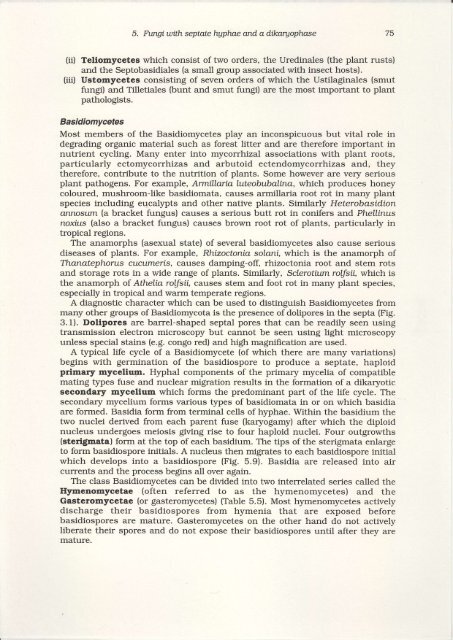Fungi with septate hyphae and a dikaryophase
Fungi with septate hyphae and a dikaryophase
Fungi with septate hyphae and a dikaryophase
You also want an ePaper? Increase the reach of your titles
YUMPU automatically turns print PDFs into web optimized ePapers that Google loves.
(ii)<br />
(iii)<br />
5. Fwtgi <strong>with</strong> <strong>septate</strong> hgphae <strong>and</strong> a dikargophase<br />
Teliomycetes which consist of two orders, the Uredinales (the plant rusts)<br />
<strong>and</strong> the Septobasidiales (a small group associated <strong>with</strong> insect hosts).<br />
Ustomycetes consisting of seven orders of which the Ustilaginales (smut<br />
furgr) <strong>and</strong> Tilletiales (bunt <strong>and</strong> smut furgi) are the most important to plant<br />
pathologists.<br />
Basidiomycetes<br />
Most members of the Basidiomycetes play an inconspicuous but vital role in<br />
degrading organic material such as forest litter <strong>and</strong> are therefore important in<br />
nutrient cycling. Many enter into mycorrhizal associations <strong>with</strong> plant roots,<br />
particularly ectomycorrhizas <strong>and</strong> arbutoid ectendomycorrhizas <strong>and</strong>, they<br />
therefore, contribute to the nutrition of plants. Some however are very serious<br />
plant pathogens. For example, ArrnilLaria tuteobubalina, which produces honey<br />
coloured, mushroom-like basidiomata, causes armillaria root rot in many plant<br />
species including eucalypts <strong>and</strong> other native plants. Similarly Heterobasidion<br />
annosum (a bracket fungus) causes a serious butt rot in conifers <strong>and</strong> PheLlinus<br />
noxius (also a bracket fungus) causes brown root rot of plants, particularly in<br />
tropical regions.<br />
The anamorphs (asexual state) of several basidiomycetes also cause serious<br />
diseases of plants. For example, Rhizoctonia solani, which is the anamorph of<br />
Thanatephorus cucumeris, causes damping-off, rhizoctonia root <strong>and</strong> stem rots<br />
<strong>and</strong> storage rots in a wide range of plants. Similarly, ScLerotium rolfsii, which is<br />
the anamorph of Athelia roLJsii, causes stem <strong>and</strong> foot rot in many plant species,<br />
especially in tropical <strong>and</strong> warm temperate regions.<br />
A diagnostic character which can be used to distinguish Basidiomycetes from<br />
many other groups of Basidiomycota is the presence of dolipores in the septa (Fig.<br />
3. f ). Dolipores are barrel-shaped septal pores that can be readily seen using<br />
transmission electron microscopy but cannot be seen using light microscopy<br />
unless special stains (e.g. congo red) <strong>and</strong> high magnification are used.<br />
A typical life cycle of a Basidiomycete (of which there are many variations)<br />
begins <strong>with</strong> germination of the basidiospore to produce a <strong>septate</strong>, haploid<br />
primary mycelium. Hyphal components of the primary mycelia of compatible<br />
mating types fuse <strong>and</strong> nuclear migration results in the formation of a dikaryotic<br />
secondary mycelium which forms the predominant part of the life cycle. The<br />
secondary mycelium forms various types of basidiomata in or on which basidia<br />
are formed. Basidia form from terminal cells of <strong>hyphae</strong>. Within the basidium the<br />
two nuclei derived from each parent fuse (karyogam5r) after which the diploid<br />
nucleus undergoes meiosis giving rise to four haploid nuclei. Four outgrowths<br />
(sterigmata) form at the top of each basidium. The tips of the sterigmata enlarge<br />
to form basidiospore initials. A nucleus then migrates to each basidiospore initial<br />
which develops into a basidiospore (Fig. 5.9). Basidia are released into air<br />
currents <strong>and</strong> the process begins all over again.<br />
The class Basidiomycetes can be divided into two interrelated series called the<br />
H5rmenomycetae (often referred to as the hymenomycetes) <strong>and</strong> the<br />
Gasteromycetae (or gasteromycetes) (Table 5.5). Most hymenomycetes actively<br />
discharge their basidiospores from hymenia that are exposed before<br />
basidiospores are mature. Gasteromycetes on the other h<strong>and</strong> do not actively<br />
liberate their spores <strong>and</strong> do not expose their basidiospores until after they are<br />
mature.<br />
75






![[Compatibility Mode].pdf](https://img.yumpu.com/27318716/1/190x135/compatibility-modepdf.jpg?quality=85)










